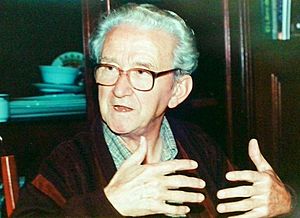José María Jimeno Jurío facts for kids
Quick facts for kids
José María Jimeno Jurío
|
|
|---|---|

José Maria Jimeno Jurío in 1997
|
|
| Born | 13 May 1927 Artajona, Pamplona
|
| Died | 3 October 2002 |
| Citizenship | Spanish |
| Occupation | Anthropologist and priest |
José María Jimeno Jurío (born May 13, 1927 – died October 3, 2002) was a Basque expert. He studied people, cultures, and history. He was also a priest for some time. He is well-known for his important work on the history and culture of Navarre, a region in Spain.
His Life Story
José María Jimeno Jurío was born in Artajona, a town in Navarre. He went to primary school there until he was twelve years old. After that, he moved to Lluch in Mallorca for a short time. He continued his education at another school there.
Later, he returned to his hometown. He studied to become a teacher and earned his diploma in 1946. After finishing his studies, he worked as a primary school teacher in Navarre. He also served in the military between 1949 and 1950.
He then joined the Seminary of Pamplona to become a priest. He became a priest, but in 1970, he decided to leave the priesthood. For several years, he was the vice president of the Society for Basque Studies. This group focuses on the Basque language and culture. He also did a lot of research for a magazine called Punto y Hora de Euskal Herria.
José María Jimeno Jurío wrote many books. These books covered the history of Navarre, its customs, languages, and traditions. He also studied toponymy, which is the study of place names. He was especially interested in place names in Navarre that came from the Basque language.
In 1991, he was made an honorary academic of the Royal Academy of the Basque Language, called Euskaltzaindia. This was a special recognition for his work.
His Family
José María Jimeno Jurío was married to Elena Aranguren. They had one son together.
Awards He Received
José María Jimeno Jurío received several awards for his important work:
- 1997: The Sabino Arana Foundation award
- 1998: The Manuel Lekuona Award
- 2015: The Navarra Gold Medal (given after he passed away)
Books He Wrote
Here are some of the books José María Jimeno Jurío wrote:
- Documentos Medievales artajoneses (Medieval Documents of Artajona), 1968.
- ¿Dónde fue la batalla «de Roncesvalles»? (Where was the Battle of Roncesvalles?), 1974. In this book, he suggested a different location for the famous battle.
- Olite monumental (Monumental Olite), 1974.
- Historia de Pamplona (History of Pamplona), 1974-1975.
- Historia de Navarra. Desde los orígenes hasta nuestros días (History of Navarre. From its Origins to Today), 1980.
- Amayur, símbolo de Navarra (Amayur, Symbol of Navarre), 1982.
- Toponimia de la cuenca de Pamplona: Cendea de Cizur (Place Names of the Pamplona Basin: Cizur Valley), 1986.
- Toponimia de la cuenca de Pamplona: Cendea de Galar (Place Names of the Pamplona Basin: Galar Valley), 1987.
- Toponimia de la cuenca de Pamplona: Cendea de Olza (Place Names of the Pamplona Basin: Olza Valley), 1989.
- Toponimia de la cuenca de Pamplona: Cendea de Iza (Place Names of the Pamplona Basin: Iza Valley), 1990.
- Estudio toponímico de Burlada (Toponymic Study of Burlada), 1991.
- Toponimia de la cuenca de Pamplona: Cendea de Ansoáin (Place Names of the Pamplona Basin: Ansoáin Valley), 1992.
- Historia de Pamplona y sus lenguas (History of Pamplona and its Languages), 1995.
- Navarra. Historia del euskera (Navarre. History of the Basque Language), 1997.
- Estella y sus calles (Estella and its Streets), 1997.
- Al airico de la tierra: tipos de la tierra (To the Land's Breeze: Types of the Land), 1997.
- Archivo General de Navarra (1194-1234) (General Archive of Navarre), 1998.
- Eunate: hito jacobeo singular (Eunate: A Unique Camino de Santiago Landmark), 1999.
- Artajona: toponimia vasca – Artaxoa: euskal toponimia (Artajona: Basque Toponymy), 1999.
- Navarra, Guipúzcoa y el euskera siglo XVIII (Navarre, Gipuzkoa, and the Basque Language in the 18th Century), 1999.
- Puente la Reina, confluencia de rutas jacobeas (Puente la Reina, Meeting Point of Camino de Santiago Routes), 2000.
See also
 In Spanish: José María Jimeno Jurío para niños
In Spanish: José María Jimeno Jurío para niños

